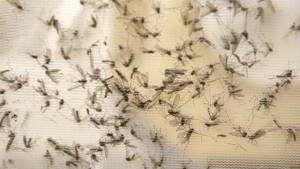 RIO DE JANEIRO, Brazil, Tuesday May 3, 2016 – With the Rio Olympics mere months away, scientists in Brazil are warning that the mosquito-borne Zika virus may be even more dangerous than previously thought.
RIO DE JANEIRO, Brazil, Tuesday May 3, 2016 – With the Rio Olympics mere months away, scientists in Brazil are warning that the mosquito-borne Zika virus may be even more dangerous than previously thought.
They told the BBC that Zika could be behind more damaging neurological conditions, affecting the babies of up to a fifth of infected pregnant women.
Most doctors and medical researchers now agree that there is a link between the Zika virus and microcephaly, a condition in which babies are born with abnormally small heads and restricted brain development.
Yet while it is estimated that only one percent of women who have had Zika during pregnancy will have a child with microcephaly, leading doctors in Brazil have told the BBC that as many as 20 percent of Zika-affected pregnancies will result in a range of other forms of brain damage to the baby in the womb.
Even more alarming, a separate study, reported in the New England Journal of Medicine, said that “29 percent of scans showed abnormalities in babies in the womb, including growth restrictions, in women infected with Zika.
“Our findings are worrisome because 29 percent of ultrasonograms showed abnormalities, including intrauterine growth restrictions and foetal death, in women with positive Zika infection,” the study said.
A rare nervous system disorder, Guillain-Barre syndrome, which can cause temporary paralysis in adults has also been linked to the infection.
The biggest concern nevertheless remains the impact the virus could have on babies developing in the womb.
Many of the conditions that Brazilian doctors are noticing in babies born to mothers who had Zika are not as obvious to the untrained eye as microcephaly.
They may not have the same impact on the child’s development either, but the frequency with which they are occurring is alarming, according to the BBC.
Renato Sa, a senior obstetrician who works in public and private hospitals in Rio de Janeiro, says there is a long list of other conditions affecting babies born to mothers who had Zika.
“There are cerebral calcifications, an increase in the number of dilation of cerebral ventricles and the destruction or malformation of the posterior part of the brain,” he says.
He adds that another concern is that often there is no obvious sign or symptom of the neurological damage until later observations of the child’s development, “perhaps convulsions or other tell-tale signs.”
Meanwhile, at the Instituto D’Or laboratories in Rio, stem-cell technology is being used to create new cells that develop like human brains. Researchers call them “mini brains” and infect them with Zika.
“What we observed is that the Zika virus is able to kill cells, is able to affect the growth of cells,” Dr Stevens Rehen, the unit’s senior neuroscientist, told the BBC.
Dr Rehen has noted, as have others, that there is something particularly virulent about the strain of Zika that arrived in Brazil and is presently spreading across the continent.
“There is something in the Zika virus that makes it more prone to kill neurocells during development. Now we need to search and understand what makes that virus more aggressive to the brain under development.”
The team was reportedly shocked by what it discovered – a huge reduction in growth of the cerebral cortex, the critical outer layer of the brain.
“The effect of the Zika virus was very impressive,” says Dr Patricia Garcez.
“We were all astonished by the fast effect. We saw cell death in three days, a massive cell death. In six days, the neurospheres were completely gone.”
Meantime, in a change to earlier patterns, the areas of greatest infection for Zika are now in the south of the country, particularly in Rio de Janeiro.
Among some sectors of society, public information campaigns about the need for using anti-mosquito repellent and taking other precautions appear to be having a positive impact.
Dr Sa says that the number of Zika cases among middle-class pregnant women has fallen sharply, as have cases of microcephaly and other related conditions.
But he says that the disappointing reality is that such progress is not apparent in the city’s many poor working-class neighbourhoods, such as Duque de Caxias in the north of Rio de Janeiro.
And Zika continues to spread across the region.
